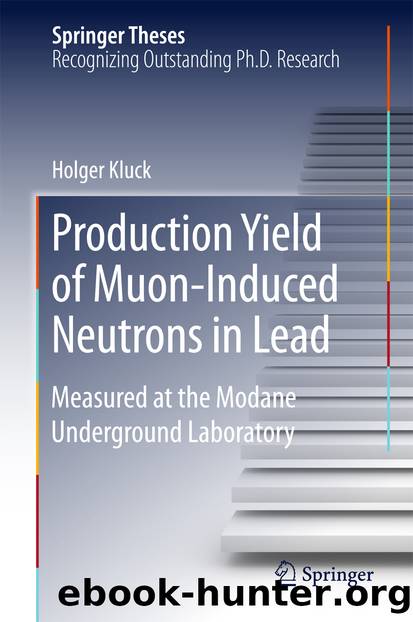Production Yield of Muon-Induced Neutrons in Lead by Holger Kluck

Author:Holger Kluck
Language: eng
Format: epub
Publisher: Springer International Publishing, Cham
Another trade off exists between the coverage of large targets and high moderation efficiency on one hand and a high efficiency of scintillation light collection on the PMTs on the other hand, as the latter is degraded in large volume detectors by internal absorption in the liquid scintillator and increased light trajectories due to multiple reflections on the detector walls. It can be further degraded by a chemical long term instability of the scintillator, leading to an increased light absorption. For the actually used liquid scintillator this is further discussed in Sects. 4.2.1, 4.3 and 4.4.3.
The efficiency may further decrease by the finite time resolution of the NMM, resulting in pile up of delayed signals, the dead time [23] of the NMM, resulting in missed signals, and the ionization quenching (Eq. 4.14a), suppressing the prompt signals from proton recoils. This is further discussed in Sect. 4.2.6. Also the measured multiplicity can get further distorted by secondary neutron production in the liquid scintillator via , [33, 75]. A selection of the related cross sections are shown in Fig. 4.1b. This effect is also evident in Fig. 4.4 for the two lines of 20 and 50 MeV neutrons: The increased detection efficiency with respect to the three lower energetic neutrons is caused by the neutron multiplication via inelastic scatterings, not only on the carbon in the scintillator but also on the lead target.
As the detection efficiency for all investigated neutron energies reaches a plateau at , this is the optimal thickness for the active volume with respect to the neutron detection. Here a neutron detection efficiency of 40 % can be expected for this configuration.
As all these effects are energy dependent, measurements of poly-energetic neutrons, like muon-induced neutrons, are not easily to correct for detection efficiencies. It is more appropriate to convolve simulated results with the detector efficiency and compare it afterwards with the measurements [33]. For this reason the next Sect. 4.2 will document in detail the detector properties, serving as input for the model of detector response in Sect. 5.4, which is then folded by the simulated neutron production in Sect. 5.5 and finally compared in Chap. 6 with the measurements in Sect. 4.5.
Download
This site does not store any files on its server. We only index and link to content provided by other sites. Please contact the content providers to delete copyright contents if any and email us, we'll remove relevant links or contents immediately.
| Atomic & Nuclear Physics | Particle Physics |
The Complete Stick Figure Physics Tutorials by Allen Sarah(6637)
Secrets of Antigravity Propulsion: Tesla, UFOs, and Classified Aerospace Technology by Ph.D. Paul A. Laviolette(3444)
Thing Explainer by Randall Munroe(3326)
The River of Consciousness by Oliver Sacks(2992)
The Order of Time by Carlo Rovelli(2714)
I Live in the Future & Here's How It Works by Nick Bilton(2524)
A Brief History of Time by Stephen Hawking(2473)
How To by Randall Munroe(2473)
The Great Unknown by Marcus du Sautoy(2184)
What If?: Serious Scientific Answers to Absurd Hypothetical Questions by Randall Munroe(2170)
Blockchain: Ultimate Step By Step Guide To Understanding Blockchain Technology, Bitcoin Creation, and the future of Money (Novice to Expert) by Keizer Söze(2136)
Midnight in Chernobyl by Adam Higginbotham(2077)
Networks: An Introduction by Newman Mark(1997)
The Meaning of it All by Richard Feynman(1909)
Easy Electronics by Charles Platt(1864)
The Tao of Physics by Fritjof Capra(1846)
When by Daniel H Pink(1775)
Midnight in Chernobyl: The Untold Story of the World's Greatest Nuclear Disaster by Adam Higginbotham(1774)
Introducing Relativity by Bruce Bassett(1754)
